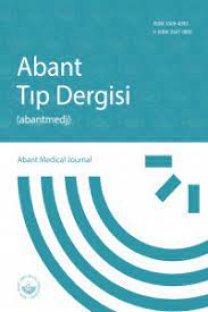Akut İskemik İnmede Damar Okluzyonu, NIHSS Skoru National Institues Of Healt Stroke Scale Scores İle Tutulan Hemisfer Arasındaki İlişki
Ulusal İnme Sağlık Ölçeği Skalası
Relationship Between NIHSS score National Institues Of Healt Stroke Scale Scores , Vessel Occlusion And Affected Hemisphere In Acute Ischemic Stroke
National Institues of Health Stroke,
___
- Luker JA, Bernhardt J, Grimmer- Somers KA. Demographic and stroke- related factors as predictors of quality of acute stroke care provided by allied health professionals. J Multidiscip Healthc. 2011; 4: 247–259. 2.
- Boone M, Chillon JM, Garcia PY, Canaple S, Lamy C, Godefroy O, Bugnicourt JM. NIHSS and acute complications after anterior and posterior circulation strokes. Therapeutics and Clinal Risk Management 2012; 8: 87–93. 3.
- Dara C, Bang J, Gottesman RF, Hillis AE. Right Hemisphere Dysfunction is Better Predicted by Emotional Prosody Impairments as Compared to Neglect. J Neurol Transl Neurosci 2014: 2(1): 1037.
- Kettunen J. Visual Neglect and Orienting Bias in Right Hemisphere Stroke Patients with and without Thrombolysis. 2013: 1455-1616 5.
- Kwah LK, Diong J. National Institutes of Health Stroke Scale (NIHSS) Journal of Physiotherapy. 2014: vol 60, issue 1, page 61 6
- strategies of care across stroke recovery: Proposals for nursing interventions in primary care. Clinical Nursing Studies 2015: Vol. 3. No. 2 7.
- Mansour OY, Megahed MM, Eman HS, Elganhy A. Acute ischemic stroke prognostication, comparison between Glasgow Coma Score, NIHSS scale and Full Outline of UnResponsiveness Score in intensive care unit. Alexandria Journal of Medicine,2014:10.002 8.
- Fischer U, Mono ML, Zwahlen M, Nedeltchev K, Arnold M, Galimanis A, Bucher S, Findling O, Meier N, Brekenfeld C, Gralla J, Heller R, Tschannen B, Schaad H, Waldegg G, Zehnder T, Ronsdorf A, Oswald P, Brunner G, Schroth G, Mattle HP, the QABE investigators. Impact of thrombolysis on stroke outcome at 12 months in a population: The Bern Stroke Project. Stroke 2012; 43: 1039–1045 9
- Shibazaki K, Sakamoto Y, Aoki J. The role of small vessel disease in re-exacerbation of stroke symptoms within 24 hours after tissue plasminogen activator infusion. Journal of Stroke and Cerebrovascular Diseases 2014; Volume 23, Issue 1, Pages 75–79
- Golsari A, Cheng B, Sobesky J, Schellinger PD, Fiehler J, Gerloff C, Thomalla G. Stroke lesion volumes and outcome are not different in hemispheric stroke side treated with intravenous thrombolysis based on magnetic resonance imaging criteria. Stroke 2015; 46: 1004–1008
- Heldner MR, Zubler C, Mattle HP, Schroth G, Weck A, Mono ML, Gralla J, Jung S, El-Koussy M, Lüdi R, Yan X, Arnold M, Ozdoba C, Mordasini P, Fischer U. National Institutes of Health Stroke Scale Score and vessel occlusion in 2.152 Patients with acute ischemic stroke. Stroke 2013; 44: 1153–1157
- Cooray C, Fekete K, Mikulik R, Lees KR, Wahlgren N, Ahmed N. Threshold for NIH stroke scale in predicting vessel occlusion and functional outcome after stroke thrombolysis. International Journal of Stroke 2015: Volume 10, Issue 5, Pages 645–788
- Hansen CK, Christensen A, Ovesen C, Havsteen I, Christensen H. Stroke severity and incidence of acute large vessel occlusions in patients with hyper- acute cerebral ischemia: results from a prospective cohort study based on CT- angiography (CTA). International Journal of Stroke 2015: Volume 10, Issue 3, pages 336–342
- Yayın Aralığı: 6
- Başlangıç: 2012
- Yayıncı: Bolu Abant İzzet Baysal Üniversitesi Tıp Fakültesi Dekanlığı
Sol ventrikül kitle imajı gibi görünen idiopatik sol ventrikül psödoanevrizması
Şeref ULUCAN, Ahmet KESER, Zeynettin KAYA, Hüseyin KATLANDUR, Hüseyin ÖZDİL
Gebelikte kalıtsal trombofili ve tromboprofilaksi
Hüsnü ALPTEKİN, Şeref ULUCAN, Türkan CENGİZ, Refika SELİMOĞLU
Şule Eda ERSÖZ, Akcan AKKAYA, Esra KOÇOĞLU, Ümit Yaşar TEKELİOĞLU, Abdullah DEMİRHAN, Murat BİLGİ, Hasan KOÇOĞLU
Muhammed Nur ÖGÜN, Bahar Aksay KOYUNCU, Özlem Güngör TUNCER, Gökhan EVCİLİ, Reha TOLUN, Yakup KRESPİ
Tuğrul ÇAKIR, Arif ASLANER, Erdem Can YARDIMCI, Ramazan GÜVEN, Uğur DOĞAN, Burhan MAYİR, Umut Rıza GÜNDÜZ, Mehmet Tahir ORUÇ
Mehmet Faruk ÇATMA, Mehmet Atıf Erol AKSEKİLİ, Kasım KILINÇARSLAN, Bahar ANAFOROĞLU, İzzet KORKMAZ, Murat ALTAY
Travmatik Penetran Diyafram Rüptürlü Yirmidört Hastanın Retrospektif Analizi
Arif ASLANER, Tuğrul ÇAKIR, Umut Rıza GÜNDÜZ, Uğur DOĞAN, Burhan MAYİR, Nurullah BÜLBÜLLER
Anti TNF-α tedavisi alan romatoloji hastalarında dermatolojik yan etkiler
Serpil TUNA, Sevil ALAN, Ülkü UÇAR, Mehmet İhsan ARMAN
Hesna Müzeyyen ASTARCI, Gülzade ÖZYALVAÇLI, Ayşe SERTÇELİK
Mevlüt KURT, Öznur CAN, Emrah POŞUL, Güray CAN, Özlem Kar KURT, Bülent YILMAZ, Uğur KORKMAZ
